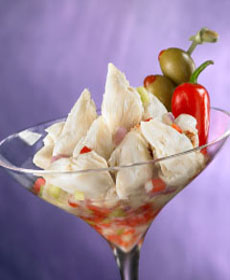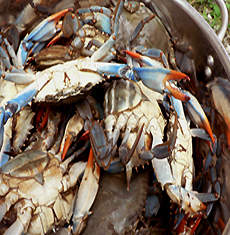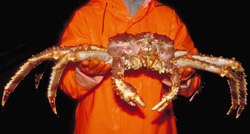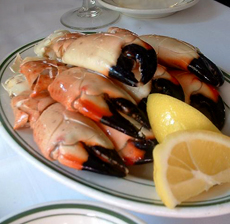

“New school” seafood cocktail: Lump crab meat in a martini glass is a “Crab Martini.” Don’t forget the olives! Photo courtesy PhillipsFoods.com. Recipe on website.
November 2007
Last Updated May 2010
|
 |
Crab Types & Grades Of Crab Meat
Page 3: Crab Glossary-Atlantic Ocean Crabs
This is Page 3 of a six-page article and glossary. Click on the black links below to see other pages.
Crab Glossary: Types Of Crabs
Crabs are a large variety of sweet-fleshed crustaceans that have a shell and five pairs of legs, the first pair of which have pinchers. They are found in both cold and warm water, mostly in salt water, although fresh-water crabs are available. Whole hard-shell crabs are available year-round in coastal areas. They can also be found canned as either jumbo lump or lump (which is whole pieces of white body meat) or flaked, also called backfin, which is small bits of meat, both light and dark, from the body and claws. In the U.S., fresh crabs are harvested on both coasts and the Gulf of Mexico. Like most shellfish, crabs are highly perishable, and canned crab meat is available—from domestic sources as well as from the Pacific Rim, South America and other origins.
There are hundreds of species of crabs in the world. Here are the major types most Americans will find in markets and restaurants.
- Soft shell crabs are not specific to any species; they are a stage in a crab’s growth, just after molting, before the new shell has had time to harden. The hard shell prevents a crab from growing; the only way it can grow larger is to throw off its old shell and grow a new one. The crab grows rapidly within a few days of casting of its shell; then the new shell grows over the larger body. Ideally, crabs must be eaten within four days of molting. They begin to rebuild their shells and are known as “papershells,” with a thin, crunchy shell that is not appealing to many people who enjoy soft shells. In the northern hemisphere, the season is from April to mid-September, and most of the soft shell crabs sold are blue crabs.
- Crab roe or coral is available only in the spring from female crabs and has been the traditional component of she-crab soup.
- Picked crab meat refers to meat that is sold picked from the shell. Perhaps 70% of picked crab meat sold in America today is imported, much of it from the Pacific Rim, where the labor force is attuned to the painstaking work. Picked crab meat is available fresh (chilled), frozen and pasteurized, the latter of which is shelf-stable (requires no refrigeration). While some of the pasteurized crab meat brands are good, some have a more canned flavor—you need to find a brand you can trust (see our review of Miller’s Select, the one pasteurized, shelf-stable canned crab with gourmet flavor). It's also much safer than fresh or frozen crab meat, which may have been shipped or stored above recommended temperatures.
Atlantic Ocean Crabs
The major Atlantic Ocean crabs are the blue crab from the Atlantic seaboard and Gulf coast, and the stone crab, which is fished from the Atlantic coast from Florida to North Carolina, and in the Gulf of Mexico from Florida to Texas (although Florida is considered the stone crab capital).
- Blue crab (Callinectes sapidus) and its close cousin, the blue swimmer crab from
 the Pacific Rim (Portunus pelagicus), are typically sold and consumed as picked crab meat, usually canned. Blue crab is the ingredient of choice for traditional American dishes like crab cakes, Crab Imperial, Crab Louis and many others. While native to the western edge of the Atlantic Ocean from Nova Scotia to Argentina, it has been introduced (inadvertently, via ballast water) to Japanese and European waters. The Chesapeake Bay, bordered by Maryland and Virginia, is famous for its blue crabs, although demand now exceeds supply. Read what happened to the Chesapeake Blue Crab in Blog.TheNibble.com. In the Chesapeake Bay area, blue crabs are most often steamed with vinegar and Old Bay Seasoning, then cracked by hand and eaten directly, often with butter and more seasoning. Photo by Michael Thompson | IST. the Pacific Rim (Portunus pelagicus), are typically sold and consumed as picked crab meat, usually canned. Blue crab is the ingredient of choice for traditional American dishes like crab cakes, Crab Imperial, Crab Louis and many others. While native to the western edge of the Atlantic Ocean from Nova Scotia to Argentina, it has been introduced (inadvertently, via ballast water) to Japanese and European waters. The Chesapeake Bay, bordered by Maryland and Virginia, is famous for its blue crabs, although demand now exceeds supply. Read what happened to the Chesapeake Blue Crab in Blog.TheNibble.com. In the Chesapeake Bay area, blue crabs are most often steamed with vinegar and Old Bay Seasoning, then cracked by hand and eaten directly, often with butter and more seasoning. Photo by Michael Thompson | IST.
- Jonah crab and rock crab are two crabs that have become popular in recent years, as merchants and restaurants seek more economical alternatives to the major crab species. From New England and the Atlantic coast of Canada, they used to be seen as “pest” crabs that competed with lobsters for bait and, when caught, were tossed back into the sea. Now Jonah crabs are fished year-round for both claws and its white body meat.
- Norwegian crab (a.k.a. Norwegian red crab or Norwegian king crab) (Paralithodes camtschaticus) is actually king crab from Alaska that was introduced to the Barents Sea by Russian scientists in the 1960s. However, instead of simply
 providing a food supply, the king crab population grew exponentially; by the 1980s they had invaded Norwegian waters, where it has no natural predators, and is endangering the environment and food supply by eating other fish (fears are that it will migrate as far south as Spain and Portugal, devouring almost everything in its path). Among the largest variety, the Norwegian crab can grow to 22 pounds and measure 4.9 feet across. While its meaty legs can sell for $25 per pound, the World Wildlife Foundation fears that the benefits of the food crop may be vastly outweighed by the long-term cost to the marine environment. providing a food supply, the king crab population grew exponentially; by the 1980s they had invaded Norwegian waters, where it has no natural predators, and is endangering the environment and food supply by eating other fish (fears are that it will migrate as far south as Spain and Portugal, devouring almost everything in its path). Among the largest variety, the Norwegian crab can grow to 22 pounds and measure 4.9 feet across. While its meaty legs can sell for $25 per pound, the World Wildlife Foundation fears that the benefits of the food crop may be vastly outweighed by the long-term cost to the marine environment.
Photo of courtesy of Alaska Fisheries Science Center, afsc.noaa.gov.
- Rock crab (a.k.a. peekytoe crab) is smaller than the Jonah crab (its claws are too small to yield meat), and the flesh has more brownish-red highlights, similar to meat from a Dungeness crab. Chefs are using meat from both Jonah and rock
 crabs, but the biggest market is food processors who blend the less-expensive meat with more expensive Dungeness or blue-crab meat. crabs, but the biggest market is food processors who blend the less-expensive meat with more expensive Dungeness or blue-crab meat.
- Stone crab (Menippe mercenarius) is a cousin of the Maryland blue crab, and tastes like a cross between the blue crab and the Maine lobster—less definitive than lobster but more so than crab. The part that is eaten, as with the Pacific crabs, is the big, meaty claw, which are very distinctive in appearance with black tips—shown in the photo at the right.
Continue To Page 4: Crab Glossary-Pacific Ocean Crabs
Go To The Index Above
Lifestyle Direct, Inc. All rights reserved. Images are the copyright of their respective owners.

|



 the Pacific Rim (Portunus pelagicus), are typically sold and consumed as picked crab meat, usually canned. Blue crab is the ingredient of choice for traditional American dishes like crab cakes, Crab Imperial, Crab Louis and many others. While native to the western edge of the Atlantic Ocean from Nova Scotia to Argentina, it has been introduced (inadvertently, via ballast water) to Japanese and European waters. The Chesapeake Bay, bordered by Maryland and Virginia, is famous for its blue crabs, although demand now exceeds supply. Read
the Pacific Rim (Portunus pelagicus), are typically sold and consumed as picked crab meat, usually canned. Blue crab is the ingredient of choice for traditional American dishes like crab cakes, Crab Imperial, Crab Louis and many others. While native to the western edge of the Atlantic Ocean from Nova Scotia to Argentina, it has been introduced (inadvertently, via ballast water) to Japanese and European waters. The Chesapeake Bay, bordered by Maryland and Virginia, is famous for its blue crabs, although demand now exceeds supply. Read  providing a food supply, the king crab population grew exponentially; by the 1980s they had invaded Norwegian waters, where it has no natural predators, and is endangering the environment and food supply by eating other fish (fears are that it will migrate as far south as Spain and Portugal, devouring almost everything in its path). Among the largest variety, the Norwegian crab can grow to 22 pounds and measure 4.9 feet across. While its meaty legs can sell for $25 per pound, the World Wildlife Foundation fears that the benefits of the food crop may be vastly outweighed by the long-term cost to the marine environment.
providing a food supply, the king crab population grew exponentially; by the 1980s they had invaded Norwegian waters, where it has no natural predators, and is endangering the environment and food supply by eating other fish (fears are that it will migrate as far south as Spain and Portugal, devouring almost everything in its path). Among the largest variety, the Norwegian crab can grow to 22 pounds and measure 4.9 feet across. While its meaty legs can sell for $25 per pound, the World Wildlife Foundation fears that the benefits of the food crop may be vastly outweighed by the long-term cost to the marine environment.  crabs, but the biggest market is food processors who blend the less-expensive meat with more expensive Dungeness or blue-crab meat.
crabs, but the biggest market is food processors who blend the less-expensive meat with more expensive Dungeness or blue-crab meat.